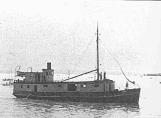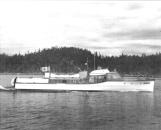15
The Ferry CITY OF NANAIMOThe CITY OF NANAIMO was built in 1892 at False Creek, Vancouver, for the Mainland and Nanaimo Steam Navigation Company set up by the Dunsmuir coal mining company of Nanaimo on Vancouver Island. Their first coal-fired side-wheel steamship, ROBERT DUNSMUIR, was nicknamed "Dirty Bob" because of the coal dust and livestock on the deck. The CITY OF NANAIMO was a more spacious vessel that competed directly with the S.S.Cutch, owned by the Union Steamship Company, for the runs from New Westminster to Vancouver, and New Westminster to Nanaimo, with syops at Steveston on the way. The rivalry and racing between these two ships ended in a collision in 1896.
17
STERNWHEELER TRANSFERThe 122-foot long, 24.5-foot wide, wooden sternwheel steamship TRANSFER was built in 1893 by Alexander Watson of New Westminster. Owned by the Canadian Pacific Navigation Company, she was used exclusively on the lower Fraser River, never going into Georgia Strait. With a draft of only 5.6 feet, she was able to dock at the wharves built over the shallow marshes on the edge of the river. Considered a "modest" vessel, without the plush elegance of other passenger steamers, she was used on the run from Chilliwack to New Westminster until 1898, and then on the daily run from New Westminster to Steveston and Ladner from 1898 to 1908. She was sold in 1909 and ended her career as a power plant for a cannery at Redonda Bay.
19
TYPICAL STEAM POWERED FREIGHTERIn 1877 Marshall English built one of B.C.'s first salmon canneries on the Fraser River near New Westminster. In 1878 he established a fish camp near the Kwlhayam village to buy salmon from Native fishermen. The camp was a scow moored to the bank, with a scow house for the camp boss. Natives fishing from dugout canoes delivered fish at certain times of day, depending on the tides, to the fish camp. Marshall English then had the salmon transported to his cannery by two steam-powered boats. The river freighter LEONORA carried fish in its hold, and the tug LEVIATHAN towed a scow. The Delta Cannery had a similar fish camp at London's Landing near Steveston from 1881 to 1885.
21
S.S. COMOXThe Union Steamship Company leased land in Vancouver and built the first steel ships north of San Francisco. The 101-foot COMOX was completed in October 1891, the 120-foot CAPILANO in December 1891, and the 127-foot COQUITLAM in April 1892. On weekdays the COMOX traveled from Vancouver up the coast to logging camps but on weekends she ran excursion trips. In July 1897 she carried passengers on an excursion to Steveston to view the fishing fleet and canneries in operation. During the 1900 fishermen's strike she carried soldiers from the Duke of Connaught's Own Rifles from Vancouver to Steveston.
23
FERRY MOTOR PRINCESSNicknamed "galloping dishpan", "jiggle box", and "stinker", the MOTOR PRINCESS ran from 1929 to 1950 between Steveston and Vancouver Island with stops at Gulf Island ports on Sundays. She was built in Esquimalt in 97 days and launched in 1923 as the first diesel ferry in the CPR fleet. At 165 feet long, 43.5 feet wide and 9 feet deep, she was designed to carry 45 cars. Stubby and squat, not sleek and yacht-like as strictly passenger ferries were, she was considered an uncomfortable misfit in the Princess Line. Despite being noisy, jerky, overpowered, and hard to steer in high seas, she was a convenient and popular method of travel. She was sold in 1956, renovated, and renamed PENDER QUEEN. She became part of the B.C. Ferry fleet in 1965.
25
THOMAS F. BAYARDThe THOMAS F. BAYARD was built in 1880 as a pilot ship for the Delaware River. This 93-foot two-masted schooner was named for an unsuccessful Democratic candidate for U.S.A. president. She made a record setting 166-day voyage around Cape Horn to San Francisco to ferry people and supplies to the Klondike Gold Rush, and sailed as a sealing schooner in the Bering Straits from 1906 to 1911. Renamed SAND HEADS NO. 16, the ship served as the Steveston lightship from 1921 to 1956, warning vessels about the shoals off the mouth of the Fraser River. After several years as a private houseboat, she was bought by the Vancouver Maritime Museum in 1977 and moored at False Creek awaiting restoration. She sank in 2002 and could not be salvaged.
27
RUM RUNNERS BRING PROFITProhibition lasted from 1916 to 1921 in Canada but continued until 1933 in the U.S.A. The chance of quick and easy profit encouraged Canadians with boats to carry liquor for sale across the border to American smugglers. There were 60 boats working from the Vancouver area alone, including the M.V. FLEETWOOD. Built in 1930 and originally named SKEEZIX, this 60-foot rum runner with her diesel engine, 2 gas aircraft engines and streamlined hull was said to be the fastest boat on the coast. At speeds of up to 40 nautical miles per hour she was well able to elude the Coast Guard cruisers. In 1934 she was converted to a luxury yacht. She was donated to the Britannia Heritage Shipyard by the family of Robert Turnbull who had owned her since 1976.






